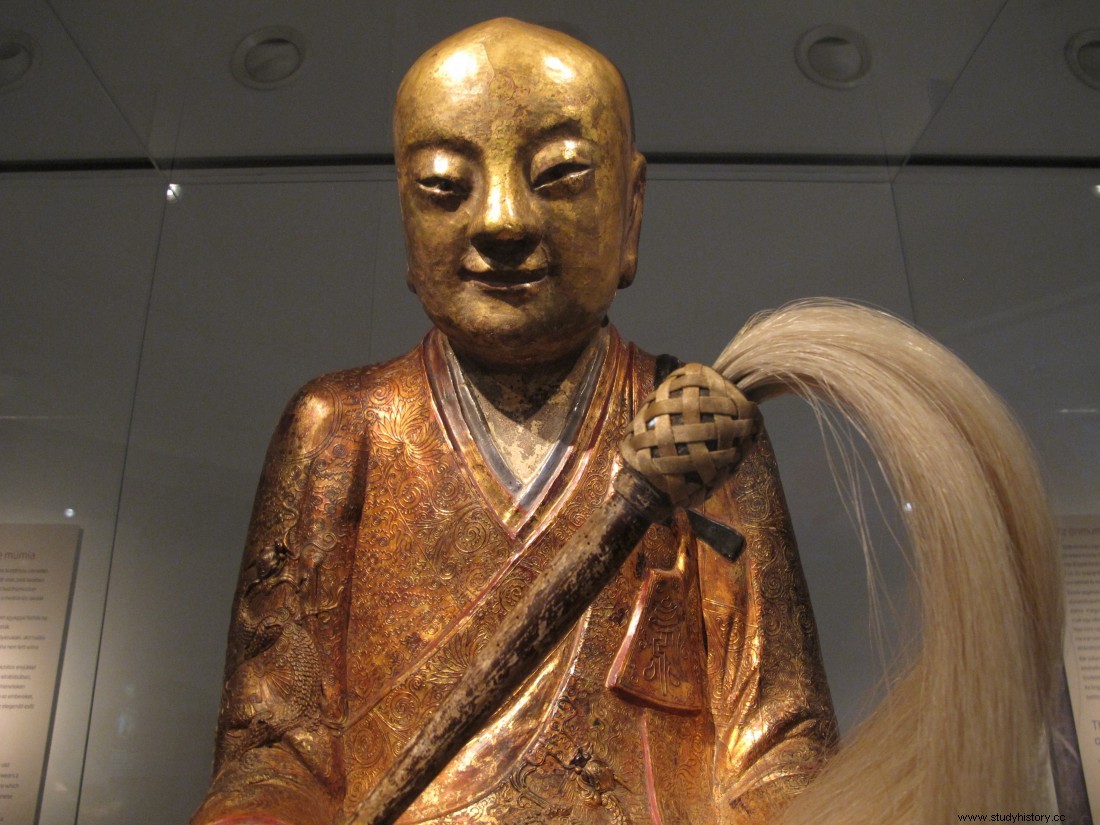 This statue – and its mummified body – would be the only known case to date in the West.
This statue – and its mummified body – would be the only known case to date in the West. HERITAGE. The people of Yangchun go on the offensive! These villagers from the province of Fujian, in southeastern China, want to recover the extraordinary statue of "Buddha with the mummy", exhibited in May 2015 at the National Museum of History in Budapest * (Hungary), qu they consider to have been stolen from them in 1995. CT-Scan analyses, carried out at the beginning of the year at the Amersfoort medical center in Rotterdam (Netherlands), had indeed revealed the extraordinary secret of this 11th century sculpture :the presence of the mummified remains of a monk under the gold lacquers, as we reported in the article dedicated to this surprising statue, in the magazine Sciences et Avenir of May 2015 (n°819). The Chinese villagers have therefore just hired lawyers with the aim of prosecuting the Dutch collector who refuses to return this treasure venerated locally for more than 1000 years, despite their repeated requests. According to them, the mummy is that of their ancestral patriarch, the monk Zhanggong Liuquan .
An amazing ritual suicide
The presence of a body inside the statue attests to a practice of "Buddhist auto-mummification" unknown in the West, consisting, for a monk, in carrying out a sort of ritual suicide by intense food fasts followed for several years. to become almost nothing but skin and bones (read box ). In China, some of these mummies are still visible in shrines, like that of Dongyan Peak. But others also exist in Thailand and other countries.

The mummified Buddha photographed in Budapest. © Bernadette Arnaud.
DEFENCE. The Dutch owner of the Buddhist statue, the architect Oscar van Overeem, has always claimed to have bought it in the Netherlands, from a collector who acquired it in Hong Kong. At first, he had seemed conciliatory by accepting the request of the villagers, before changing his mind. It is therefore to a group of jurists led by Liu Yang – who earned his stripes by recently successfully recovering antiquities looted by Anglo-French forces in the former Summer Palace in Beijing (China) in 1860 – that the case has been assigned to be brought before the courts of the Netherlands by the end of November. According to the Chinese agency Xinhua , "in Dutch law, the time limits for civil disputes being 20 years, and the collector claiming that he acquired the statue in 1996, the period of validity for the recovery of the relic will expire next year ".
Self-mummification
It is a form of ritual mummification of the body that is very impressive - since it was carried out during his lifetime - and has been practiced (in a very confidential way) over the centuries by a few great Buddhist masters. The first reported case in China – in " Biographies of Eminent Monks "– date of 459. About fifty of these cases would have been counted between the 5
e
and the 10
th
century. These extreme and very rare behaviors, rejected by the main religious currents, were then introduced in Japan from the 8
e
-9
e
century as part of the Shugendo school , where the followers of this rite took the name of Yamabushi or Shugen, before spreading to Tibet, Vietnam, Korea or Thailand between the 12
e
and the 15
th
century. They were totally banned in Japan from 1872.
* The Mummy World exhibition , which was held from 1 st October 2014 to May 17, 2015 at the Hungarian Natural History Museum in Budapest (Hungary), displayed the Buddhist statue only a few months (during which we were able to see it) before it was removed from display cases to be returned to the Netherlands, as soon as the first complaints were made. The exhibition – of which this Buddha was the highlight – should then have gone to the National Museum of Art History in Luxembourg until January 2016.
